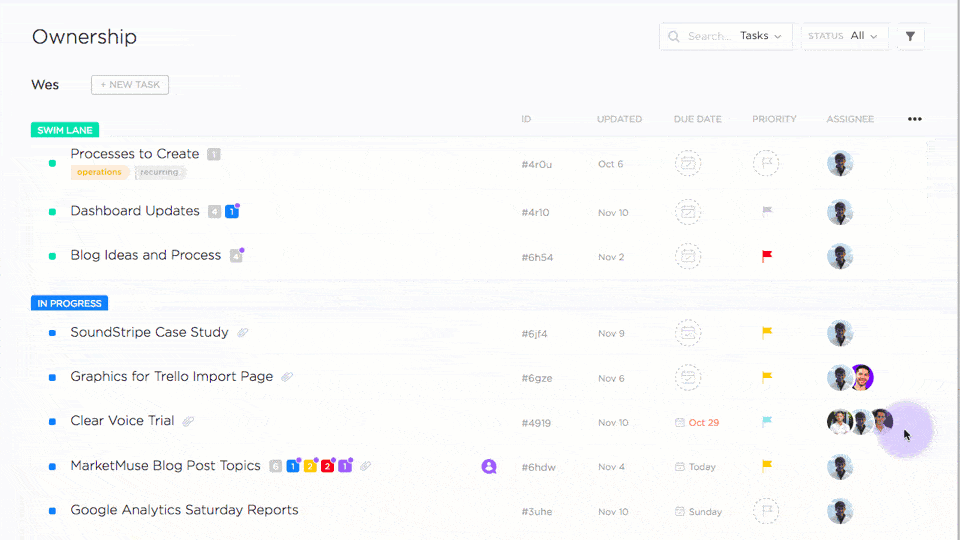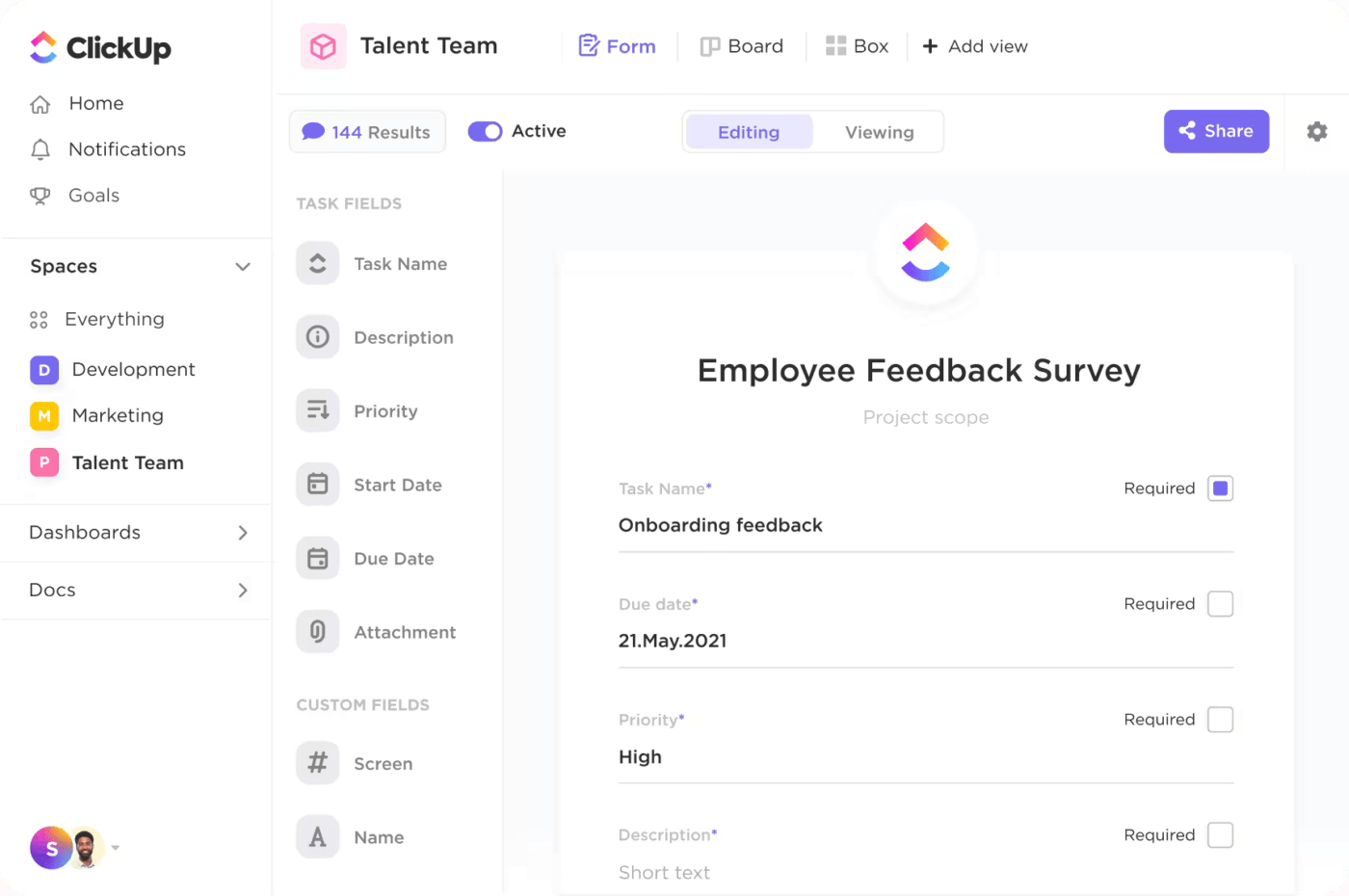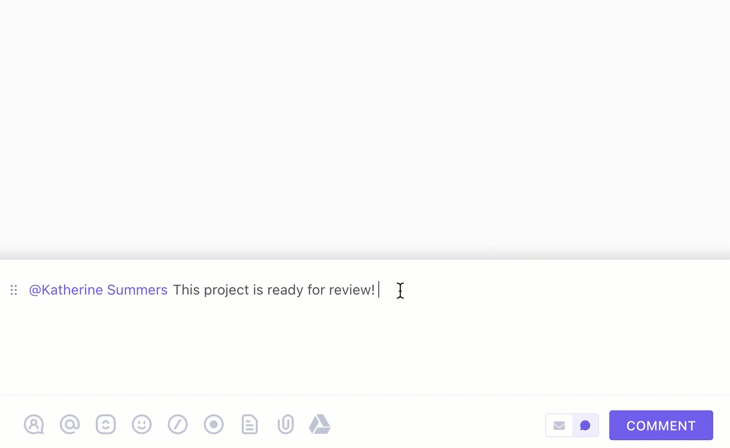على الرغم من التقدم التكنولوجي، ستظل مشاكل التواصل في مكان العمل موجودة دائماً. وتشمل هذه المشاكل اختلافات المناطق الزمنية، والحواجز اللغوية والثقافية، والافتقار إلى هياكل تواصل موحدة. ويمكنها أن تؤثر بشكل كبير تؤثر على كفاءة الشركة وإنتاجيتها . ويكتسب هذا الأمر أهمية خاصة في عالم معولم حيث غالبًا ما تكون فرق العمل منتشرة في مناطق زمنية وقارات مختلفة. 🌐
تضيع الرسائل في الترجمة، في حين أن المواعيد النهائية الفائتة والردود المتأخرة غالبًا ما تحدث بسبب اختلافات المناطق الزمنية.
لكن هناك تدابير استباقية يمكنك اتخاذها لتقليل تحديات التواصل في مكان العمل. دعنا نلقي نظرة فاحصة على بعض الاستراتيجيات العملية التي ستساعدك على تجاوز العقبات الشائعة والانتصار عليها.
أهمية التواصل الفعال في مكان العمل
في صميم كل عمل تجاري ناجح، التواصل الجيد هو المفتاح. فهو يربط كل شيء معًا، ويساعد الأشخاص على التواصل، ومشاركة الأفكار، وإعطاء وتلقي الملاحظات، وتتبع التقدم المحرز. عندما يكون التواصل قويًا، تزدهر العلاقات، وتنطلق الأفكار الجديدة، وينمو العمل. 🌱
يتجاوز التواصل الفعال إرسال رسائل البريد الإلكتروني أو حضور الاجتماعات أو كتابة التقارير. بل يتعلق الأمر بتعزيز بيئة يشعر فيها الجميع بأن أفكارهم وآراءهم مهمة ويشعرون فيها بأنهم مرتبطون بالمؤسسة. فالموظفون الذين يتم الاستماع إليهم وفهمهم من المرجح أن يستمروا في العمل.
عندما يزدهر التواصل، يزدهر الابتكار أيضًا. فهو يثير الأفكار الإبداعية التي يمكن أن تدفع عملك إلى الأمام. ويساعد على تحديد المشاكل وحلها بسرعة، مما يوفر الوقت والموارد.
بالإضافة إلى ذلك، يعزز التواصل الفعال الروح المعنوية والإنتاجية. عندما توصيل التوقعات والأهداف بوضوح، يعرف فريقك ما يجب أن يهدف إليه، مما يقلل من الارتباك ويعزز الكفاءة. إن الاعتراف بجهود فريقك وتقديرها يحفزهم على القيام بعمل أفضل.
مشاكل التواصل الشائعة في مكان العمل وحلولها
من المحتمل أن تكون قد واجهت سوء التواصل في مكان عملك، مثل الحمل الزائد للمعلومات أو نقص التغذية الراجعة أو عدم كفاية مشاركة المعرفة أو التواصل أحادي الاتجاه.
يعد فهم هذه التحديات والتعامل معها أمرًا ضروريًا لتعزيز التعاون السلس وضمان إنجاز المشروع في الوقت المناسب. فيما يلي مشاكل التواصل الأكثر شيوعًا في مكان العمل وحلولها.
المشكلة 1: الحمل الزائد للمعلومات
قد يبدو العمل وكأنه طوفان من المعلومات القادمة من أماكن مختلفة، مثل رسائل البريد الإلكتروني، ورسائل الدردشة، ووسائل التواصل الاجتماعي، ومواقع الشركة الإلكترونية. عند مواجهة ذلك، من السهل أن تفوتك معلومات مهمة.
فيما يلي أربعة استراتيجيات التواصل لمساعدتك في إدارة الحمل الزائد من المعلومات:
- تحديد الأولويات: ليست كل المعلومات ذات أولوية متساوية. تعلّم التمييز بين المعلومات العاجلة والمهمة والتافهة
- التنظيم: حافظ على تنظيم مساحة عملك ورسائل البريد الإلكتروني والملفات. استخدم أدوات للمساعدة في إدارة صندوق الوارد الخاص بك ومصادر المعلومات الأخرى
- تفويض: إن أمكن,تفويض المهام التي تتضمن معالجة معلومات أقل أهمية
- قطع الاتصال: لا بأس من قطع الاتصال في بعض الأحيان. يمكن أن يساعدك أخذ فترات راحة قصيرة من تدفق المعلومات المستمر في الحفاظ على سلامة عقلك وإنتاجيتك
نصيحة احترافية: يمكن أن تساعدك أدوات إدارة المهام في تحديد أولويات العمل. مع انقر فوق المهام يمكنك تعيين مستويات الأولوية والعمل على القضايا الأكثر إلحاحًا. تنظيم مساحة العمل الخاصة بك والملفات والمجلدات لإدارة المعلومات بفعالية.

قم بتنظيم مهامك بناءً على الأهمية من خلال أولويات المهام في ClickUp
المشكلة 2: عدم وجود ملاحظات
تعتبر الملاحظات بمثابة خارطة طريق للتحسين، حيث تحدد مجالات القوة وفرص النمو حتى تتمكن من مواصلة التطور المهني. إذا كنت تشعر بأنك غير متأكد، يجب عليك:
- شجّع فريقك على مناقشة تقديم الملاحظات البناءة
- اطلب من مديرك أن يطمئنك بانتظام على أدائك
نصيحة احترافية: نموذج استبيان آراء الموظفين واستطلاع آراء الموظفين في ClickUp يبسط تقييم رضا الموظفين، وتحديد مجالات التحسين، ورفع الروح المعنوية من خلال عمليات تقييم فعالة.

في طريقة عرض استبيان آراء الموظفين، يمكنك صياغة وتعديل وإزالة الأسئلة الخاصة بالاستبيان الخاص بك
/ctaBtn/الأخضر https://app.clickup.com/signup?template=t-211272976 تنزيل هذا النموذج /%ctaBtnTn/
المشكلة 3: ضعف مشاركة المعرفة
عندما لا تتعاون أجزاء مختلفة من الشركة، قد ينتهي الأمر بالأشخاص إلى القيام بنفس العمل، أو تفويت الفرص لمساعدة بعضهم البعض، أو ارتكاب الأخطاء لأنهم لا يملكون جميع المعلومات الصحيحة. إذا كانت المعلومات المهمة مبعثرة في كل مكان، فمن الصعب على الجميع العثور على ما يحتاجون إليه بسرعة.
لإصلاح هذه المشكلة في مكان العمل، احرص على مشاركة الجميع ما يعرفونه وتسهيل عملهم معًا ووضع جميع المعلومات في مكان واحد يسهل العثور عليها. 📚
إحدى الطرق الجيدة للقيام بذلك هي إعداد نظام داخل الشركة يساعد الموظفين على التواصل مع بعضهم البعض وتتبع البيانات القيمة.
المشكلة 4: التواصل أحادي الاتجاه
عندما يكون التواصل في العمل يسير في اتجاه واحد فقط، يصبح التعاون صعباً وقد يشعر الموظفون بعدم الارتباط. قد تشعر بأن لا أحد يستمع إليك أو يهتم بأفكارك، مما يجعلك تشعر بأنك لا تنتمي إلى العمل. من الضروري الخروج من نمط التواصل الضعيف.
_التحدث بصراحة
تشارك الأفكار
تأكد من مشاركة الجميع
أيها القادة، أنتم لستم مجرد مذيعين بل مستمعين نشطين. نفذوا اجتماعات منتظمة للفريق وجلسات العصف الذهني وصناديق الاقتراحات - ستلاحظون الفرق.
نصيحة للمحترفين: أبقِ الجميع على اطلاع باستخدام لوحات معلومات ClickUp . احصل على رؤى واضحة حول إنتاجية كل عضو من أعضاء الفريق وعبء العمل الخاص به، وحدد الاختناقات المحتملة. احصل على جميع البيانات معروضة بدقة من خلال الرسوم البيانية والمخططات والبطاقات والقوائم وغيرها. 📊

استخدم لوحات معلومات ClickUp لتصور جميع المهام والحفاظ على شفافية العلاقات بين أعضاء الفريق
المشكلة 5: حواجز التواصل
مثلما يمكن أن يؤثر التواصل أحادي الاتجاه سلباً على الإنتاجية ومشاركة الموظفين، فإن حواجز التواصل تعيق التعاون الفعال في أماكن العمل المتنوعة. وتشمل هذه الحواجز عادةً ما يلي:
- الاختلافات اللغوية والثقافية: تعزيز الوعي الثقافي واحترام التنوع يساعد على تقليل سوء الفهم
- الاعتماد المفرط على التواصل الرقمي: في حين أن التكنولوجيا يمكن أن تعزز التواصل، إلا أن الاعتماد المفرط عليها يمكن أن يؤدي إلى سوء الفهم. وازن بينها وبين المحادثات المباشرة وجهاً لوجه
- الحواجز المادية: يمكن أن تشجع تخطيطات المكاتب المفتوحة على التفاعل وإزالة العوائق المادية أمام التواصل
- الحواجز العاطفية: يمكن للمشاعر السلبية مثل الخوف أو الاستياء أن تمنع التواصل المفتوح. عزز بيئة عمل إيجابية لكسر هذه الحواجز
المشكلة 6: عدم وجود خط واضح للتواصل
عدم وجود خط اتصال واضح يعني عدم معرفة من تقدم له التقارير، أو من تطلب منه المساعدة، أو حتى أين يتناسب عملك مع الصورة الأكبر. وهذا يمكن أن يؤدي إلى الارتباك والتأخير وحتى الأخطاء. 💢
الحلول بسيطة!
_ضع تسلسلاً هرميًا واضحًا للتواصل والتزم به
_تأكد من أن الجميع يعرف إلى من يرفعون تقاريرهم وكيف يجب أن تتدفق المعلومات
_شجع على الحوار المفتوح، ولا تغلق قنوات الاتصال
المشكلة 7: ضعف التواصل في مرحلة الإعداد
عندما ينضم شخص جديد إلى شركة، من المفيد جدًا مساعدته على الاستقرار في أدواره بفعالية. وهذا يعني إعطائهم تعليمات وتدريبات واضحة، خاصة إذا كانوا يعملون من المنزل. يمكن أن يجعل العمل عن بُعد من الصعب على الموظفين الجدد الشعور بالتواصل مع الفريق حيث لا تتاح لهم فرص كثيرة للدردشة مع زملائهم في العمل.
لتسهيل العملية، يمكن للمدراء استخدام أدوات التواصل لجميع المعلومات الخاصة بالتأهيل وتقديم الموظفين الجدد تدريجياً بدلاً من تقديمهم دفعة واحدة.
المشكلة 8: قنوات الاتصال غير المتسقة
يمكن أن تؤثر طريقة التواصل بشكل كبير على الإنتاجية والتعاون وثقافة الشركة، بغض النظر عما إذا كانت شركة ناشئة صغيرة أو شركة متعددة الجنسيات. أحد العناصر المهمة والمهملة أحيانًا في التواصل الداخلي هو الحفاظ على الاتساق عبر القنوات.
يمكن لقنوات التواصل غير المعوقة، سواء داخليًا داخل الفرق أو خارجيًا عبر الأقسام، أن تحسن الكفاءة وتحقق نتائج إيجابية.
يمكن أن يؤدي التبديل المستمر بين الأدوات والمنصات المختلفة إلى إرباك الموظفين وإضاعة وقتهم وإعاقة الإنتاجية في نهاية المطاف. من الضروري إنشاء قناة اتصال موثوقة يستخدمها الجميع. 💬
نصيحة احترافية: استخدم خاصية الإشارات في ClickUp للإشارة إلى الأفراد أو فرق العمل بأكملها وتعزيز الشفافية والفعالية التواصل في مكان العمل .

استخدم ميزة @mention للإشارة إلى أفراد أو فرق كاملة للمساعدة في الحفاظ على شفافية التواصل.
المشكلة 9: المعلومات الخاطئة
المعلومات المضللة ليست نميمة أو خلاف غير ضار. يشير المصطلح إلى المحاولة المتعمدة لتصوير معلومات خاطئة على أنها صحيحة. ويعبر العديد من الأفراد عن مخاوفهم بشأن احتمال حدوث هذه الظاهرة.
ولمكافحة المعلومات المضللة، يمكنك
- إنشاء قنوات اتصال واضحة داخل الشركات لتبادل المعلومات الدقيقة على الفور
- توفير دورات تدريبية حول مهارات التحقق من الحقائق ومهارات التفكير النقدي لمساعدة الموظفين على التمييز بين المصادر الموثوقة والمصادر الخاطئة
- تشجيع القادة على أن يكونوا مثالاً يُحتذى به من خلال تقديم تواصل صادق وشفاف باستمرار
تحديات التواصل الشائعة مع العمل عن بُعد
يوفر العمل عن بُعد المرونة والراحة، ولكنه يمثل أيضًا تحديات فريدة للتواصل الفعال في مكان العمل.
لنقارن بين هذه المزايا والتحديات وكيفية تأثيرها على فرق العمل عن بُعد. راجع الجدول أدناه:
| المزايا | التحديات |
|---|---|
| المرونة:التواصل الواضح يمكّن الموظفين من تنسيق جداول العمل بفعالية | عوائق التواصل: يمكن أن يؤدي التفاوت في المنطقة الزمنية وغياب التفاعل الشخصي إلى إعاقة التواصل الفعال، مما يؤدي إلى سوء الفهم |
| تحسين التعاون: تسهّل منصات التواصل الفعال التعاون السلس بين فرق العمل عن بُعد، مما يعزز الإنتاجية والإبداع | العقبات التقنية: قد تؤدي المشاكل التقنية مثل اتصالات الإنترنت غير الموثوقة أو قيود المعدات إلى تعطيل تدفق الاتصالات والإنتاجية |
| تعزيز العلاقات: التواصل المنتظم والشفاف يعزز الروابط القوية بين أعضاء الفريق عن بُعد، مما يخفف من مشاعر العزلة والوحدة | العزلة الاجتماعية: يمكن أن تؤدي ظروف العمل عن بُعد إلى تفاقم مشاعر العزلة والوحدة، مما يؤثر على معنويات الفريق وتماسكه |
| حل المشاكل بفعالية: قنوات الاتصال المفتوحة تمكّن الموظفين من معالجة التحديات على الفور، مما يؤدي إلى حل أسرع وسير عمل أكثر سلاسة | صعوبات في تحقيق التوازن بين العمل والحياة الشخصية: صعوبة الفصل بين ساعات العمل والوقت الشخصي قد يؤدي إلى الإرهاق وانخفاض الرفاهية بشكل عام |
نصائح للتواصل الفعال عن بُعد
إليك بعض النصائح السهلة للتغلب على التحديات وتحسين التواصل عن بُعد:
- تعرف على أدوات مثل Zoom أو Slack أو Microsoft Teams للبقاء على اتصال مع فريقك
- مراعاة المناطق الزمنية: تنسيق الاجتماعات والمواعيد النهائية مع مراعاة ساعات عمل الجميع باستخدام تقويم مشترك عبر الإنترنت
- كن واضحًا وموجزًا: تجنب سوء الفهم من خلال التحديد والإيجاز في رسائلك، ولا تتردد في الإفراط في التواصل عند الحاجة
- استخدم التواصل المرئي: عزز رسائلك باستخدام لقطات الشاشة والرسوم البيانية والرموز التعبيرية لنقل المعلومات بشكل أكثر فعالية
- أنشئ قنوات للتغذية الراجعة: شجّع فريقك على مشاركة أفكارهم ومخاوفهم، مما يعزز ثقافة الانفتاح والشمولية
مكافأة القراءة:_ تحقق من أعلى كتب مهارات التواصل .
## التواصل بين الثقافات في مكان العمل
من خلال احترام ثقافات بعضنا البعض والتعلم من ثقافات بعضنا البعض، نجمع بين وجهات النظر والمواهب المختلفة، وهو أمر مفيد للدبلوماسية والأعمال والتعايش بسلام. ☮️
هناك خطوات يمكنك اتخاذها لتحسين التواصل بين الثقافات:
- حاول أن تتعلم أساسيات اللغات الأخرى التي يتحدث بها زملاؤك
- تعامل مع طريقة عمل الجميع باحترام. فهذا يساعد على بناء الثقة والتفاهم
- اطلب من الجميع مشاركة أفكارهم بصراحة يوقف المشاكل قبل حدوثها
- استخدم التطبيقات أو البرامج التي تقوم بالترجمة الفورية للغات. إنها تسهل على الجميع فهم بعضهم البعض، حتى لو كانوا يتحدثون لغة مختلفة
دور وسائل التواصل الاجتماعي والبريد الإلكتروني في التواصل في مكان العمل
إن دور وسائل التواصل الاجتماعي والبريد الإلكتروني في التواصل في مكان العمل متعدد الأوجه، حيث يخدم كل منهما أغراضاً مختلفة ويقدم مزايا وعيوباً فريدة من نوعها.
تعزز وسائل التواصل الاجتماعي التواصل عبر وسائل التواصل الاجتماعي الشعور بالانتماء للمجتمع والانتماء بين الموظفين. فهي توفر منصة للاحتفال بالإنجازات ومشاركة أخبار الشركة، وبالتالي تعزيز ثقافة الشركة الإيجابية. 📱
ومع ذلك، يمكن أن يؤدي الطابع غير الرسمي لوسائل التواصل الاجتماعي في بعض الأحيان إلى طمس الحدود المهنية، مما يؤدي إلى سوء تواصل محتمل أو الإضرار بالسمعة بسبب منشورات أو تعليقات غير لائقة.
من ناحية أخرى، يوفر التواصل عبر البريد الإلكتروني قناة رسمية ومهنية للتفاعل، مما يسهل حفظ سجلات يمكن الاعتماد عليها للمناقشات والعقود. وتسمح طبيعته غير المتزامنة بالمرونة في توقيت الاستجابة.
ولكن، يمكن التغاضي عن رسائل البريد الإلكتروني أو تجاهلها، مما يؤدي إلى فقدان المعلومات أو تأخر الردود. وعلاوة على ذلك، قد يؤدي الاعتماد المفرط على البريد الإلكتروني إلى تقليل التفاعل وجهاً لوجه، مما يؤدي إلى الشعور بالعزلة بين أعضاء الفريق.
عندما يتعلق الأمر بالتواصل عبر البريد الإلكتروني، إليك أربع نصائح بسيطة:
- اجعلها واضحة وموجزة لجذب الانتباه
- استخدم لغة بسيطة واجعل رسالتك قصيرة
- حافظ على نبرة صوتك محترمة وتجنب العامية
- تحقق دائمًا من الأخطاء قبل الإرسال
نصيحة احترافية: البريد الإلكتروني ClickApp يجمع بين وظائف إدارة العمل ووظائف البريد الإلكتروني داخل ClickUp، مما يتيح لك بسهولة إرسال واستقبال رسائل البريد الإلكتروني مباشرةً داخل المهمة التي تعمل عليها.

إرسال وإدارة رسائل البريد الإلكتروني ضمن منصة واحدة شاملة مع ميزة إدارة البريد الإلكتروني في ClickUp
طرق التغلب على تحديات التواصل في مكان العمل
التغلب على التحديات التي تواجه التواصل الفعال في مكان العمل في متناول يدك. يمكنك دمج استراتيجيات مثل:
- التعاون في الوقت الحقيقي
- مشاركة الشاشة
- الوسائل البصرية
- التغذية الراجعة المشجعة أدوات العمل مثل انقر فوق مساعدتك في تحقيق هذه الأهداف. مع ميزات واسعة النطاق مثل تعيين المهام، وترك التعليقات، والحصول على تحديثات في الوقت الفعلي، يجعل ClickUp من السهل على الفرق التواصل بسلاسة وحل المشاكل والوصول إلى أهدافهم.
لذا، دعونا نرى ذلك على أرض الواقع! 🎬
1. التعاون في الوقت الحقيقي
يؤدي استخدام الأدوات التي تسمح بالتواصل في الوقت الفعلي مع أعضاء فريقك إلى خلق بيئة يشعر فيها الأشخاص بالراحة في طلب المساعدة، ويقلل من التأخير ويساعد الجميع على العمل معًا لإيجاد الحلول.

تمكين العمل الجماعي السلس مع طريقة عرض الدردشة في ClickUp طريقة عرض الدردشة في ClickUp مجموعة متنوعة من الميزات لتعزيز التواصل بين الفريق، بما في ذلك:
- قنوات منظمة: إعداد قنوات مميزة مخصصة لمختلف المشاريع أو المواضيع، مثل مركز الأفكار الإبداعية أو ركن خدمة العملاء
- وضع العلامات: جذب انتباه شخص ما بسرعة عن طريق الإشارة إليه بعلامة @اسم المستخدم
- التعليقات وردود الفعل: أضف تعليقات أو تفاعل باستخدام الرموز التعبيرية لجعل المحادثات أكثر جاذبية وتخصيصًا
- تواصل سريع*: تواصل سريع: استخدم عرض الدردشة للأسئلة والتوضيحات والتعليقات السريعة، مما يقلل من الاعتماد على رسائل البريد الإلكتروني أو التعليقات
عندما يتعلق الأمر بإنشاء المستندات أو العروض التقديمية أو العصف الذهني, مستندات ClickUp هو محرر النصوص في الوقت الفعلي وأداة إدارة المستندات. ويمكنك ربط مستنداتك بالمهام وقوائم المراجعة وسير العمل لإحياء الأفكار، حتى لو كان فريقك يعمل عن بُعد أو مختلطاً. ومع كشف التعاون في ClickUp's Collaboration Detection يمكنك أن ترى متى يقوم الآخرون بالتعليق أو التحرير أو عرض المستند نفسه الذي تقوم أنت بالتعليق عليه أو تحريره أو عرضه.
2. مشاركة الشاشة
تتيح لك مشاركة المحتوى على الشاشة أثناء الاجتماعات توجيه المشاركين، مما يضمن اطلاع الجميع على نفس المعلومات. وهذا يمنحك تحكماً أفضل في الجلسات التعاونية .

شارك رسالة فيديو ClickUp الخاصة بك من خلال رابط متصفح مباشر لا يتطلب أي تنزيلات ويمكن مشاهدته على الفور بعد التسجيل
مع كليك أب كليب , التواصل الداخلي في غاية السهولة. يمكنك تسجيل الشاشة أو رسائل الفيديو مباشرةً في متصفح الويب الخاص بك (كروم أو فايرفوكس) دون أي متاعب.
سواء أكنت بحاجة إلى شرح عملية عمل معقدة أو حفظ تفاصيل مهمة من اجتماع مع عميل، فإن ClickUp يوفر لك كل ما تحتاجه. لا داعي للتوتر بشأن تدوين الملاحظات أثناء الاجتماعات بعد الآن - اضغط على زر التسجيل ودع ClickUp Clip يقوم بالعمل نيابةً عنك.
بالإضافة إلى ذلك، يمكنك اختيار نوع التسجيل المفضل لديك:
- تسجيل شاشتك بالكامل
- نافذة تطبيق معين
- علامة تبويب متصفح
3. الوسائل المرئية
عندما يتعلق الأمر بمعالجة عقبات التواصل، فإن الوسائل البصرية هي أفضل صديق لك. فهي تجعل المفاهيم الصعبة أسهل بكثير في استيعابها.

عزز التعاون الإبداعي وتصور المشروع باستخدام سبورة ClickUp Whiteboards ClickUp Whiteboards هي طريقة ممتازة للفرق للعمل معًا بشكل إبداعي. فهي توفر مساحة مرئية حيث يمكن للجميع مشاركة الأفكار والعصف الذهني.
الملاحظات اللاصقة هي وسيلة أخرى لتغيير قواعد اللعبة. حيث يمكنك تدوين الأفكار وتحريكها مثل قطع لعبة اللوح. إنها ممتازة للحصول على مدخلات الجميع والتغلب على عوائق التواصل.
مع انقر فوق الخرائط الذهنية يمكنك تنظيم أفكارك وأفكارك بشكل مرئي، مما يسهل عليك رؤية الروابط والصورة الكبيرة.
مكافأة القراءة: تعلم كيفية استخدام قوالب خطة التواصل لتحسين التعاون وتبسيط العمليات دون الشعور بالإرهاق.
4. تشجيع التغذية الراجعة
من خلال جعل فريقك يشعر بأن آراءهم مهمة، يمكنك إنشاء مكان يمكن للجميع فيه مشاركة أفكارهم بصراحة، ولا تكون التعليقات مقبولة فقط - بل يتم تشجيعها.
على سبيل المثال، إذا كنت بحاجة إلى تعليقات على الصور أو مقاطع الفيديو أو ملفات PDF، يمكنك تقديم ميزة التدقيق في ClickUp لفريقك. فهي تتيح لهم ترك تعليقاتهم مباشرةً على المرفقات، مما يسهل على أعضاء الفريق تقديم أفكارهم واقتراحاتهم.

مشاركة المستندات مع أعضاء الفريق في المهمة وجمع الملاحظات حول أصول التصميم دون مغادرة ClickUp
التغلب على عقبات التواصل باستخدام ClickUp
يتطلب التغلب على تحديات التواصل المشتركة الأدوات والاستراتيجيات والأساليب الصحيحة. ومن خلال خطة تواصل قوية، يمكن للجميع العمل معاً لتحقيق الأهداف المشتركة. انضم إلى ClickUp الآن لاستخدام الأدوات المناسبة للعمل الجماعي، وتشجيع الجميع على المشاركة في اجتماعات المشروع، وإنشاء مكان عمل آمن ومفتوح. ساعد فريقك على الاستعداد لمواجهة التحديات معًا. 💪

